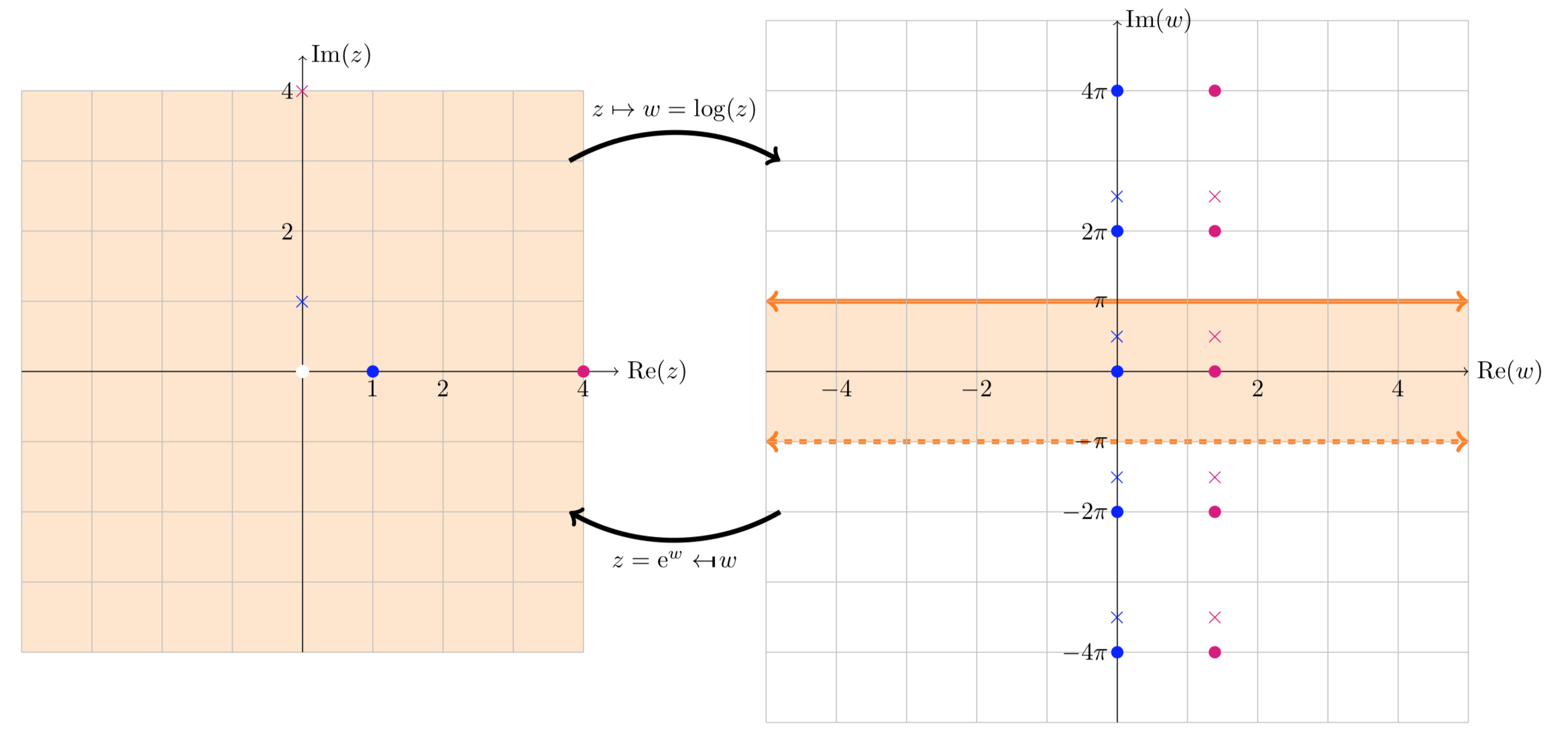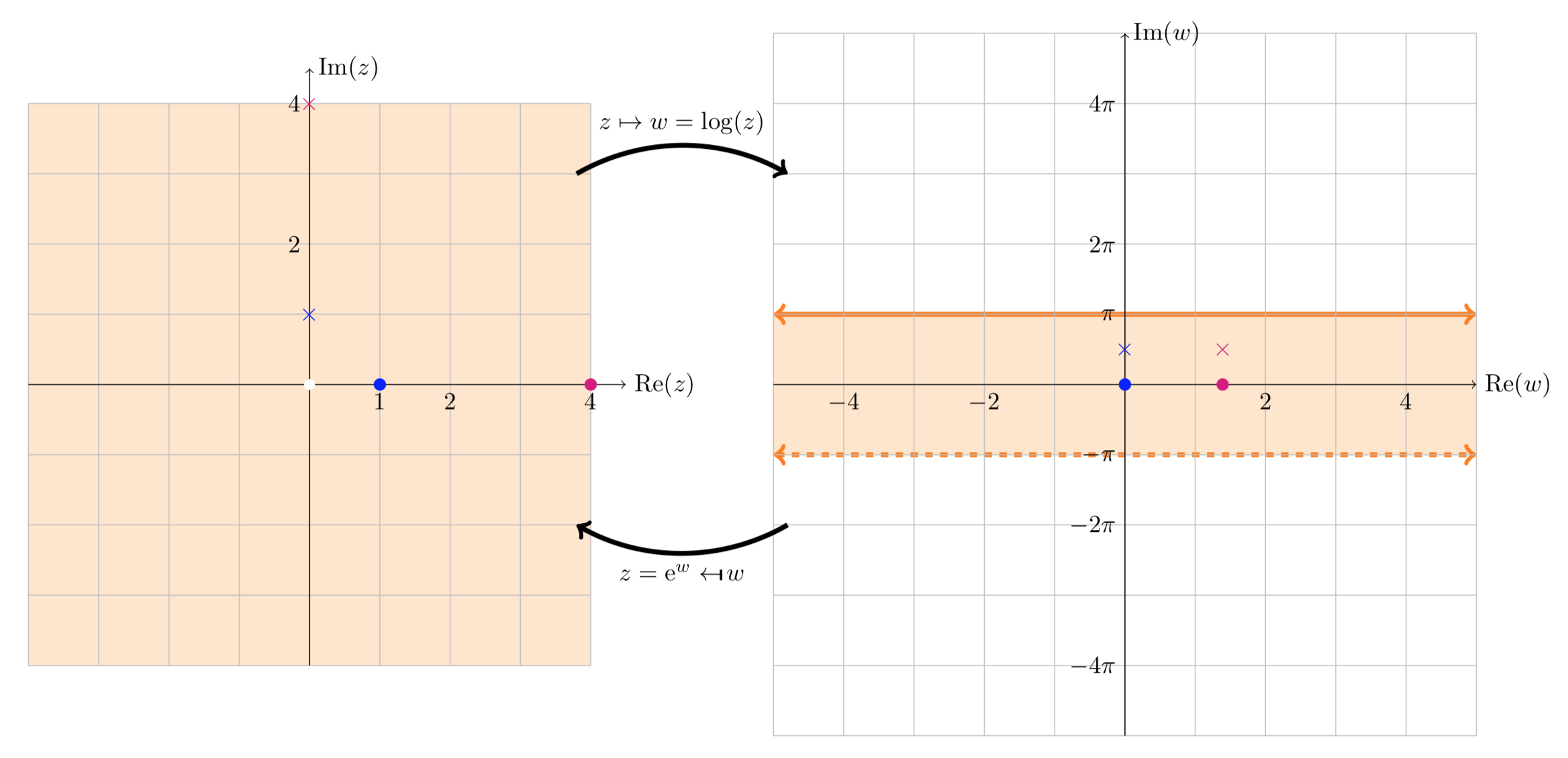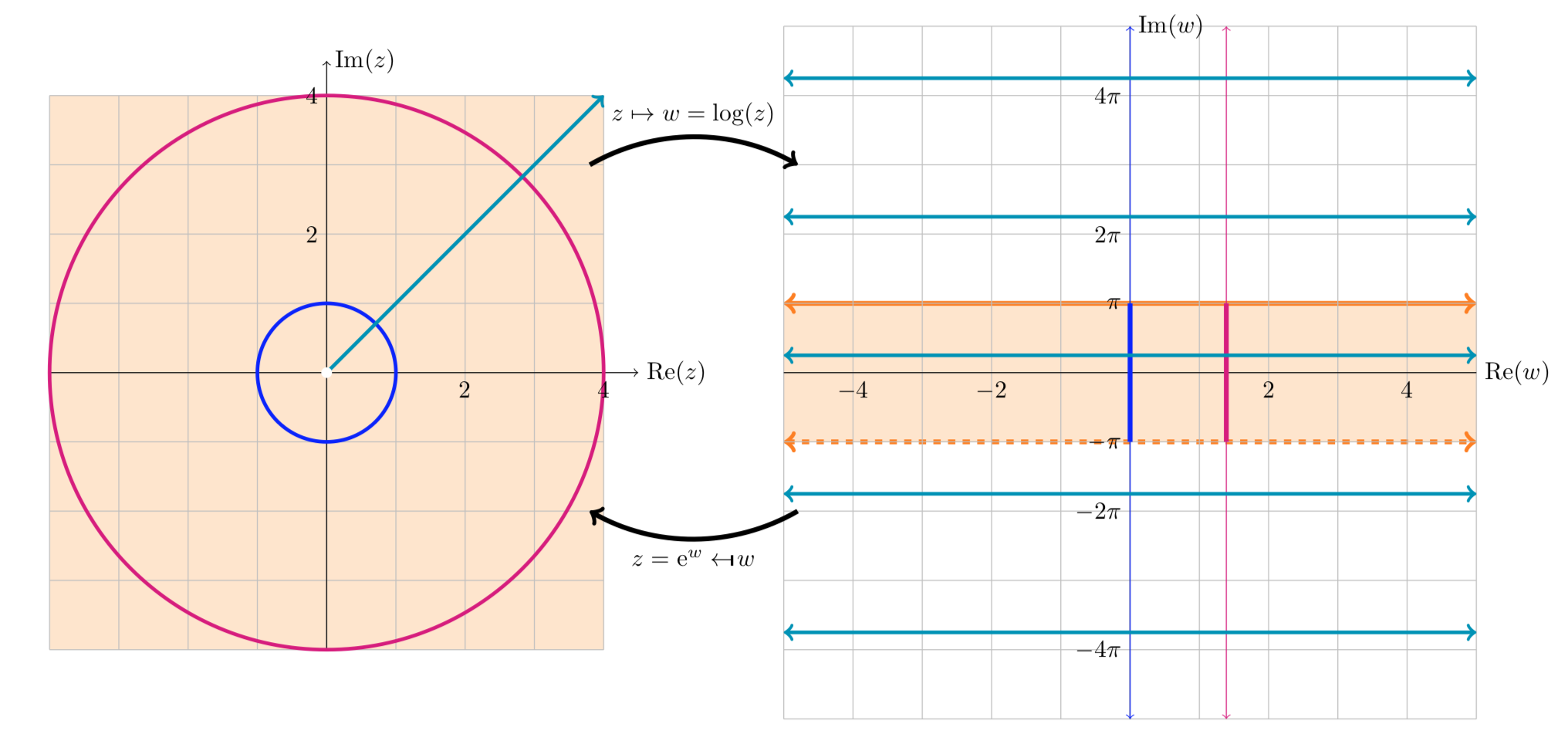1.11: The Function log(z)
( \newcommand{\kernel}{\mathrm{null}\,}\)
Our goal in this section is to define the log function. We want log(z) to be the inverse of ez. That is, we want elog(z)=z. We will see that log(z) is multiple-valued, so when we use it we will have to specify a branch.
We start by looking at the simplest example which illustrates that log(z) is multiple-valued.
Find log(1).
Solution
We know that e0=1, so log(1)=0 is one answer.
We also know that e2πi=1, so log(1)=2πi is another possible answer. In fact, we can choose any multiple of 2πi:
log(1)=2nπi
where n is any integer.
This example leads us to consider the polar form for z as we try to define log(z). If z=reiθ then one possible value for log(z) is
log(z)=log(reiθ)=log(r)+iθ,
here log(r) is the usual logarithm of a real positive number. For completeness we show explicitly that with this definition elog(z)=z:
elog(z)=elog(r)+iθ=elog(r)eiθ=reiθ=z
Since r=|z| and θ=arg(z) we have arrived at our definition.
The function log(z) is defined as
log(z)=log(|z|)+iarg(z),
where log(|z|) is the usual natural logarithm of a positive real number.
Remarks.
- Since arg(z) has infinitely many possible values, so does log(z).
- log(0) is not defined. (Both because arg(0) is not defined and log(|0|) is not defined.)
- Choosing a branch for arg(z) makes log(z) single valued. The usual terminology is to say we have chosen a branch of the log function.
- The principal branch of log comes from the principal branch of arg. That is,
log(z)=log(|z|)+iarg(z), where −π<arg(z)≤π (principal branch).
Compute all the values of log(i). Specify which one comes from the principal branch.
Solution
We have that |i|=1 and arg(i)=π2+2nπ, so
log(i)=log(1)+iπ2+i2nπ=iπ2+i2nπ,
where n is any integer.
The principal branch of arg(z) is between −π and π, so Arg(i)=π/2. Therefore, the value of log(i) from the principal branch is iπ/2.
Compute all the values of log(−1−√3i). Specify which one comes from the principal branch.
Solution
Let z=−1−√3i. Then |z|=2 and in the principal branch Arg(z)=−2π/3. So all the values of log(z) are
log(z)=log(2)−i2π3+i2nπ.
The value from the principal branch is log(z)=log(2)−i2π/3.
Figures showing w=log(z) as a mapping
The figures below show different aspects of the mapping given by log(z).
In the first figure we see that a point z is mapped to (infinitely) many values of w. In this case we show log(1) (blue dots), log(4) (red dots), log(i) (blue cross), and log(4i) (red cross). The values in the principal branch are inside the shaded region in the w-plane. Note that the values of log(z) for a given z are placed at intervals of 2πi in the w-plane.

Mapping log(z):log(1),log(4),log(i),log(4i)
The next figure illustrates that the principal branch of log maps the punctured plane to the horizontal strip −π<Im(w)≤π. We again show the values of log(1),log(4),log(i),log(4i). Since we’ve chosen a branch, there is only one value shown for each log.

Mapping log(z): the principal branch and the punctured plane
The third figure shows how circles centered on 0 are mapped to vertical lines, and rays from the origin are mapped to horizontal lines. If we restrict ourselves to the principal branch the circles are mapped to vertical line segments and rays to a single horizontal line in the principal (shaded) region of the w-plane.

Mapping log(z): mapping circles and rays
Complex Powers
We can use the log function to define complex powers.
Let z and a be complex numbers then the power za is defined as
za=ealog(z).
This is generally multiple-valued, so to specify a single value requires choosing a branch of log(z).
Compute all the values of √2i. Give the value associated to the principal branch of log(z).
Solution
We have
log(2i)=log(2eiπ2)=log(2)+iπ2+i2nπ.
So,
√2i=(2i)1/2=elog(2i)2=elog(2)2+iπ4+inπ=√2eiπ4+inπ.
(As usual n is an integer.) As we saw earlier, this only gives two distinct values. The principal branch has Arg(2i)=π/2, so
√2i=√2e(iπ4)=√2(1+i)√2=1+i.
The other distinct value is when n=1 and gives minus the value just above.
Cube roots: Compute all the cube roots of i. Give the value which comes from the principal branch of log(z).
Solution
We have log(i)=iπ2+i2nπ, where n is any integer. So,
i1/3=elog(i)3=eiπ6+i2nπ3
This gives only three distinct values
eiπ/6,ei5π/6,ei9π/6
On the principal branch log(i)=iπ2, so the value of i1/3 which comes from this is
eiπ/6=√32+i2.
Compute all the values of 1i. What is the value from the principal branch?
Solution
This is similar to the problems above. log(1)=2nπi, so
1i=eilog(1)=ei2nπi=e−2nπ,
where n is an integer.
The principal branch has log(1)=0 so 1i=1.


